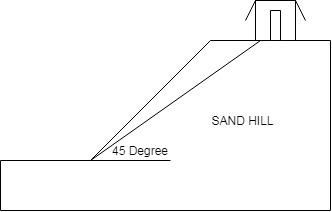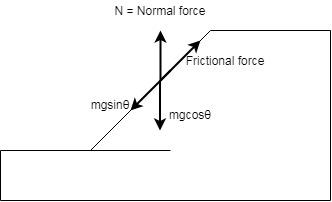
A house is built on the top of a hill with \[45^\circ \]slope. Due to the sliding of material and sand from top to the bottom of the hill, the slope angle has been reduced. If the coefficient of static friction between sand particles is 0.75, what is the final angle obtained by hill? (${\tan ^{ - 1}}0.75 = 37^\circ $ ).

A) $8^\circ $
B) $45^\circ $
C) $37^\circ $
D) $30^\circ $
Answer
127.8k+ views
Hint: Here we have to use the concept of resolution of forces. Here, we need to find the equilibrium of the sand. So to do that we need to find equations for all the forces so that the net forces are equal to zero.
Complete step by step solution:
Resolve forces and find the angle:

Resolve the vertical and the horizontal forces,
$N = mg\cos \theta $; …(m = mass, g = acceleration due to gravity)
Now, resolve the horizontal forces equate them together.
$\mu N = mg\sin \theta $; …(Frictional force = $\mu N$)
Put the value of N in the above equation:
$\mu \times mg\cos \theta = mg\sin \theta $;
Solve for the coefficient of friction and cancel out the terms with same values.
$\mu = \dfrac{{mg\sin \theta }}{{mg\cos \theta }}$;
$\mu = \tan \theta $;
Solve for the angle;
${\tan ^{ - 1}}\mu = \theta $;
Put the value of coefficient of friction which is 0.75.
${\tan ^{ - 1}}0.75 = \theta $;
The angle is:
$\theta = 37^\circ $;
Hence, Option (C) is correct. The final angle attained by the hill is $37^\circ $.
Note: Here the sand is sliding that means the forces on the sand are not in equilibrium. When the sand stops sliding that means the net force on the sand is equal to zero. Here, draw a diagram specifying each of the forces acting on the sand. Find the unknown angle.
Complete step by step solution:
Resolve forces and find the angle:

Resolve the vertical and the horizontal forces,
$N = mg\cos \theta $; …(m = mass, g = acceleration due to gravity)
Now, resolve the horizontal forces equate them together.
$\mu N = mg\sin \theta $; …(Frictional force = $\mu N$)
Put the value of N in the above equation:
$\mu \times mg\cos \theta = mg\sin \theta $;
Solve for the coefficient of friction and cancel out the terms with same values.
$\mu = \dfrac{{mg\sin \theta }}{{mg\cos \theta }}$;
$\mu = \tan \theta $;
Solve for the angle;
${\tan ^{ - 1}}\mu = \theta $;
Put the value of coefficient of friction which is 0.75.
${\tan ^{ - 1}}0.75 = \theta $;
The angle is:
$\theta = 37^\circ $;
Hence, Option (C) is correct. The final angle attained by the hill is $37^\circ $.
Note: Here the sand is sliding that means the forces on the sand are not in equilibrium. When the sand stops sliding that means the net force on the sand is equal to zero. Here, draw a diagram specifying each of the forces acting on the sand. Find the unknown angle.
Recently Updated Pages
Difference Between Vapor and Gas: JEE Main 2024

Area of an Octagon Formula - Explanation, and FAQs

Difference Between Solute and Solvent: JEE Main 2024

Absolute Pressure Formula - Explanation, and FAQs

Carbon Dioxide Formula - Definition, Uses and FAQs

Charle's Law Formula - Definition, Derivation and Solved Examples

Trending doubts
JEE Main 2025 Session 2: Application Form (Out), Exam Dates (Released), Eligibility & More

Class 11 JEE Main Physics Mock Test 2025

JEE Main Exam Marking Scheme: Detailed Breakdown of Marks and Negative Marking

JEE Main 2025: Conversion of Galvanometer Into Ammeter And Voltmeter in Physics

JEE Mains 2025 Correction Window Date (Out) – Check Procedure and Fees Here!

Learn About Angle Of Deviation In Prism: JEE Main Physics 2025

Other Pages
JEE Advanced Marks vs Ranks 2025: Understanding Category-wise Qualifying Marks and Previous Year Cut-offs

NCERT Solutions for Class 11 Physics Chapter 1 Units and Measurements

Units and Measurements Class 11 Notes: CBSE Physics Chapter 1

NCERT Solutions for Class 11 Physics Chapter 2 Motion In A Straight Line

Important Questions for CBSE Class 11 Physics Chapter 1 - Units and Measurement

Laws of Motion Class 11 Notes: CBSE Physics Chapter 4




